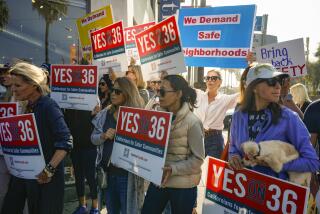The 5 rules on how to kill a consumer-friendly initiative

California’s initiative process can shine a bright light on how money and influence work their magic in American politics.
Unlike in the legislature, there are no back rooms where favors can be traded; everything’s got to be done in public — campaign contributions are subject to public disclosure, and what you see in campaign ads is what you get.
That doesn’t mean that money and influence can’t get their way, only that they have to step up their game in deceit and misdirection.
There are six statewide measures before voters on Nov. 4, but it’s the battle over Proposition 45 where the techniques of anti-consumer influence are most openly exposed for examination.
The measure would allow the state insurance commissioner, an elected official, to set health insurance rates. This is a power that the insurance commissioner already has over auto and property/casualty insurers, and that insurance regulators have over health insurance in 35 states and the District of Columbia.
Proposition 45 is abominated by the insurance industry, which has provided virtually all of the $37 million collected to fight the initiative. The measure’s backers have collected or spent about $3.6 million. Of that, $1 million has come from the California Nurses Assn. and much of the rest from consumer attorneys and Consumer Watchdog, the group sponsoring the measure.
We can boil down the methods of the No on 45 campaign to five rules that instruct and illustrate how to kill a consumer-friendly initiative.
Rule 1: Pick a name that conceals your purpose. This is absolutely fundamental. The anti-45 campaign operates under the title of “Californians Against Higher Health Care Costs.” The “Californians” part gives the campaign a nice populist ring, as though we’re all in this together. “Higher healthcare costs”? No one could be for that, so the campaign looks like a flag-carrier for the public weal.
It’s deceptive, of course, since the opposition’s goal is to prevent the insurance commissioner from gaining the authority to keep rates down. But “Californians for Protecting Insurance Company Revenues” wouldn’t have quite so much zing.
Rule 2: Portray yourself as the friend of the consumer, even though you’re bankrolled by big business. Proposition 45 “will increase costs for consumers and harm the quality of our healthcare,” asserts the No on 45 campaign. That line about “our” healthcare is a nice touch, aligning the initiative’s opponents with your interests and mine.
You and I are nowhere to be found in the contributor roster of Californians Against Higher Health Care Costs, updated by the secretary of state as of last week. The biggest donors are Kaiser, which so far this year has put up $14.3 million; WellPoint (the parent of Anthem Blue Cross), nearly $12.7 million; and Blue Shield of California, nearly $9.7 million. They account for 98% of the total raised.
The Kaiser and Blue Shield contributions should draw your particular attention. Unlike WellPoint, those entities are nonprofits. Every dollar they spend on this campaign is a dollar that could be diverted from patient care.
When I asked Kaiser and Blue Shield for comments, both referred me to the PR flacks for the No on 45 campaign. That’s pure cowardice. They must be afraid that their spending is indefensible. If Proposition 45 passes, the state insurance commissioner would have the legal right to ask about precisely this sort of outlay, and disallow it as a component of insurance rates. Is there any wonder why they’re spending so lavishly to kill Proposition 45?
Rule 3: “Special Interests”? They’re always the other guys. The No on 45 campaign is built around the claim that the measure is backed by “special interests who stand to make millions.” These costs are “ultimately paid by consumers,” the campaign says.
It’s referring to nonprofit organizations such as Consumer Watchdog, the measure’s sponsor. These organizations would be empowered to challenge insurance rate hikes as “intervenors,” and could get their expenses paid if they succeed in rolling them back.
The arrangement was pioneered in Proposition 103, which made the insurance commissioner an elected post with jurisdiction over other insurance lines. Over the last 12 years, judges have awarded Consumer Watchdog and its outside attorneys a total of $9 million in cases the group says have resulted in more than $3 billion in rate rollbacks.
If you’re counting, the organization and its attorneys have collected 29 cents for every $100 in rate reduction. By that measure, their fees are paid out of the savings flowing to consumers — savings that might not have occurred without their intervention.
This is a reminder that when businesses grouse about “special interests,” they mean special interests other than themselves. The insurers fighting Proposition 45 want to remain the belles of the special-interest ball, and they’re willing to spend more than $37 million to wear the glass slippers.
Rule 4: For maximum flexibility, be parsimonious with information. The No on 45 commercials feature doctors and others fretting that Proposition 45 would interfere with “the new independent commission established last year to negotiate rates and benefits for consumers.” What is this “independent commission”? The board of Covered California, the state insurance exchange established under the Affordable Care Act.
The ads don’t identify the “commission” because the No on 45 people want you to think that it’s a body with all the power the insurance commissioner would have under Proposition 45. That’s deceptive. They have different purposes and different jurisdictions. In fact, the Covered California board sees Insurance Commissioner Dave Jones as a potential adversary in rate regulation. The board’s failure to see the virtues of a truly independent set of eyes on insurance rates, including its own, is one indication that it’s beginning to think like an insurance company itself — not an encouraging development for Californians.
Rule 5: There’s no such thing as elected officials or government administrators; they’re either “politicians” or “unelected bureaucrats.” This rule was used to kill healthcare reform in 1993, during the Clinton administration.
The airwaves were filled with the infamous “Harry and Louise” commercials developed by political PR men Ben Goddard and Rick Claussen. Harry and Louise fretted about their insurance bill at their kitchen table, while a voice-over warned that with the Clinton reforms “the government may force us to pick from a few healthcare plans designed by government bureaucrats.”
Now the shoe is on the other foot. Among the No on 45 campaign’s political consultants is the same Rick Claussen who helped develop that ad. Only now the pitch is that “government bureaucrats” offering “a few healthcare plans” — that’s the Covered California system — need to be protected from oversight by “one politician” with “too much power.”
The assumption underlying the No on 45 campaign is that voters have short attention spans and shorter memories. With a huge budget, microscopic scruples and morals, and these five rules, you can fool the electorate into thinking that multibillion-dollar insurance companies have their interests at heart and nonprofit consumer advocates are in it only for the money. Will the same scheme work this time?
Michael Hiltzik’s column appears Sundays and Wednesdays. Read his blog, the Economy Hub, at latimes.com/business/hiltzik, reach him at mhiltzik@latimes.com, check out facebook.com/hiltzik and follow @hiltzikm on Twitter.
More to Read
Get the L.A. Times Politics newsletter
Deeply reported insights into legislation, politics and policy from Sacramento, Washington and beyond. In your inbox three times per week.
You may occasionally receive promotional content from the Los Angeles Times.










